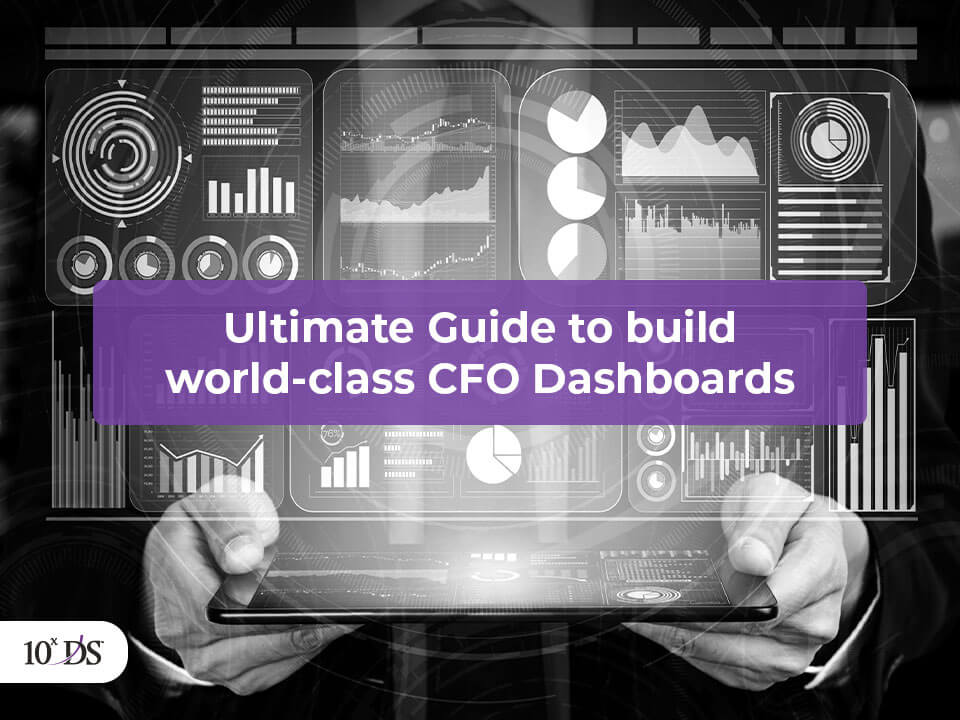
Ultimate Guide to build world-class CFO Dashboards
The evolution of a Chief Financial Officer (CFO)’s role from typical number focus and cost analysis to growth strategy, sales strategy and even human resources has created a demand for more oversight. In addition to this, the CFO is also expected to provide timely, accurate updates to a variety of stakeholders.
With so much responsibility and such little time, financial data analysis is not an easy feat to achieve. Fortunately, the current crop of emerging digital solutions, which is at our disposal can help us surmount the herculean challenge of working efficiently with the fiscal data.
The CFO dashboard serves as a centralized and interactive data hub for the key financial information which the company is tracking and consolidated from disparate data sources. The dashboard contains the Key KPI matrices and intuitive analytical tools which can be easily deciphered augmenting the strategic and analytical efforts related to the financial aspects of the business.
Top CFO Dashboards Metrics
Following are some of the top commonly used Metrics as part of the CFO Dashboards.
1. Net Income
Net Income is calculated as the difference between Sales and Cost of goods sold and expenses and is used to assess how much revenue exceeds the expenses of an organization.
2. Working Capital
Working Capital is the difference between the Current Assets and Liabilities of a company and is a measure of a company’s liquidity, operational efficiency, and its short-term financial health.
3. Operating Cash Flow
Operating Cash Flow is a measure of the amount of cash generated by a company’s normal business operations and indicates whether it can generate sufficient positive cash flow to maintain and grow its operations.
4. Payroll Headcount
Payroll Headcount is the total number of people employed by an organization including full time and part-time employees.
5. Current Ratio
The current ratio is a liquidity ratio that measures a company’s ability to pay short-term obligations or those due within one year. It gives an indication to investors and short-term analysts how a company can maximize the current assets on its balance sheet to satisfy its current debt and other payables.
6. Debt to Equity Ratio
The debt-to-equity (D/E) ratio is calculated by dividing a company’s total liabilities by its shareholder equity and is a measure of the degree to which a company is financing its operations through debt versus wholly-owned funds
7. Accounts Payable Turnover
The accounts payable turnover ratio is a short-term liquidity measure used to quantify the rate at which a company pays off its suppliers and shows efficient a Company is at paying its suppliers and short-term debts.
8. Accounts Receivable Turnover
The accounts receivable turnover ratio is an accounting measure used to quantify a company’s effectiveness in collecting its receivables or money owed by clients. The ratio shows how efficient a Company is in collecting the receivables from the Clients.
9. Total Sales
Total sales denote the total sales of a company, unadjusted for the costs related to generating those sales and is calculated by totalling all sale invoices or related revenue transactions.
10. Budget Variance
Budget variance is a periodic measure used by the company to quantify the difference between budgeted and actual figures for a particular accounting category. A favourable budget variance refers to gains and an unfavourable budget variance refers to losses for the Company.
11. Customer Satisfaction
Customer Satisfaction scores will help the Company closely monitor the high-value accounts and flag the ones which are on the verge of leaving. This will help alert the Sales/Account management team to take proactive measures with respect to the Customer.
Points to Consider while Building CFO Dashboards
Focusing on the below points and the right tools will help in building successful CFO dashboards:
1. Understand the ultimate financial goals
The first step would be to understand the ultimate financial goals of the Company which will serve as the foundation for the analytical effort behind the dashboards. Collaborating with key financial staff would help understand the objectives to be achieved and you will be able to tailor the dashboards accordingly.
2. Choose the matrices that are strongest indicators of performance
Once the outcomes and goals are defined, the next step is to select the right CFO Dashboard KPIs that would help portray and decipher the most important performance indicators for the Company which will help to channelize your business efforts in an exponential manner.
3. Leveraging Advanced/Cutting Edge Analytical capabilities
Choosing the right BI reporting tools are a pre-requisite for building a successful CFO Dashboard and following are the features that the tool should possess:
- The tool should possess advanced analytical capabilities and have the flexibility to customize the Dashboards as per the requirements
- Easy to use User interface and the dashboards/reports should be accessible with a minimum number of clicks
- Visually appealing and dynamic KPIs that will easily help the user formulate strategic decisions
- The hosting model should offer both on-premise and Cloud offerings
- The tool should be accessible from multiple devices like mobile, tablet 24/7
- Last but not the least, the tool should offer a robust Customer Support
4. Interactive and Intuitive Dashboards
The Dashboards for the CFO should be both interactive and intuitive offering drill-down features rolling down to detailed data and Projections. All of this would help the CFO to probe and get answers to critical questions like if the firm is heading in the right direction with respect to the goals defined, what are the things the Company should focus to achieve long term/short term objectives, among others.
5. Follow Dashboard design principles and best practices
After consolidating data from multiple sources and identifying the most appropriate matrices, following are a few dashboard designs practices that needs to be followed for the CFO Dashboard data to be easily analysed and actionized:
a) Information should be Precise
Effective design is about presenting information and the relation information clearly and making the user interface as intuitive as possible. Use tabs, filters,
Selectors, drill-downs only when required
b) Provide Context
Numbers on a dashboard do not convey any meaning to the users or indicate if any action required without providing context. Examples of providing context include naming all the axes, adding titles to charts comparison against a set target, against a preceding period, against a projected value are all examples of providing context.
c) Easy to decipher
The data analysis displayed on the dashboard should be done in a clear and approachable way enabling the user to clearly get the information he/she was looking for without doing any calculation. For example, if there are 2 relative values in the dashboard, adding a ratio to show an evolution or proportion to make things even clearer.
d) Layout should be carefully chosen
A poor layout will lead to users spending more time to look for data amongst charts and numbers. Useful layout principles include:
- Placing key information on the upper left corner of the screen
- Always start with the big picture or major trend followed by more detailed charts
- Grouping the charts having comparable matrices together
e) Use the right type of chart
All the hard work behind data visualization can be lost without choosing the right type of chart and hence it is imperative to choose the chart with the right data visualization to convey the intended information.
Talk to our experts to know more and build a world-class dashboard platform for the CFOs!
Reference: Investopedia for the key matrices definitions


